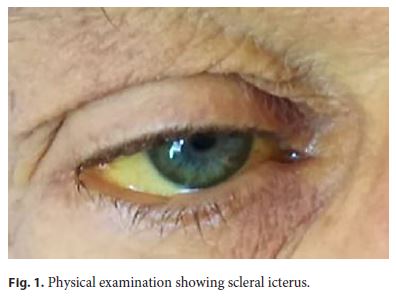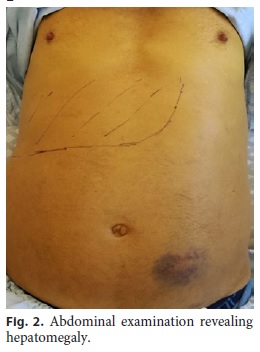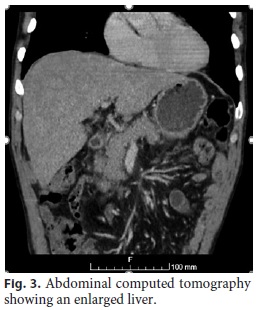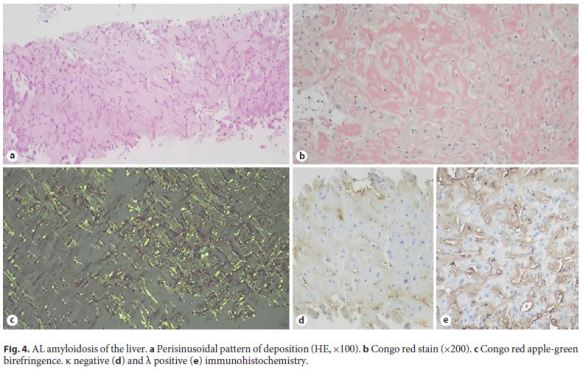Serviços Personalizados
Journal
Artigo
Indicadores
Links relacionados
Compartilhar
GE-Portuguese Journal of Gastroenterology
versão impressa ISSN 2341-4545
GE Port J Gastroenterol vol.26 no.6 Lisboa dez. 2019
https://doi.org/10.1159/000496185
CLINICAL CASE STUDY
A Case of Severe Cholestasis due to Hepatic AL Amyloidosis
Um caso de colestase grave por amiloidose AL com envolvimento hepático
Teresa Diasa,b, Diana Ferreiraa,b, Hélder Moreirac, Telma Nascimentod, Arsénio Santosa,b, Armando Carvalhoa,b
aDepartment of Internal Medicine, Centro Hospitalar e Universitário de Coimbra, Coimbra, Portugal; bFaculty of Medicine, University of Coimbra, Coimbra, Portugal; cDepartment of Pathology, Centro Hospitalar e Universitário de Coimbra, Coimbra, Portugal; dDepartment of Hematology, Centro Hospitalar e Universitário de Coimbra, Coimbra, Portugal
* Corresponding author.
ABSTRACT
Introduction: Immunoglobulin light chain-associated amyloidosis results from extracellular tissue deposition of fibrilforming monoclonal immunoglobulin light chains, secreted by a clone of plasma cells. Although the liver is often involved histologically, most cases are clinically asymptomatic, and severe intrahepatic cholestasis as the primary manifestation of the disease is rare. Clinical Case: We report an unusual case of primary amyloidosis in a 71-year-old man, presenting with rapidly progressive cholestasis, associated with hepatomegaly. There are a few reported cases in the literature of cholestasis and acute liver failure as the first manifestations of AL amyloidosis. Conclusion: Infiltrative diseases, such as amyloidosis, must be considered when a patient presents with cholestatic hepatitis. A liver biopsy is essential for the diagnosis of amyloidosis when liver test abnormalities dominate the initial clinical presentation. Liver involvement in patients with amyloidosis is often an indicator of poor prognosis.
Keywords: Cholestasis, Amyloidosis, Liver, Myeloma
RESUMO
Introdução: A amiloidose associada a cadeias leves resulta da deposição tecidular de cadeias leves de imunoglobulina monoclonal, segregada por um clone de células plasmáticas. Embora o fígado esteja com frequência envolvido histologicamente, a maioria dos casos é clinicamente assintomática, e a colestase intra-hepática grave como manifestação primária da doença é rara. Caso clínico: Os autores relatam um caso raro de amiloidose primária num homem de 71 anos, manifestando colestase rapidamente progressiva, associada a hepatomegalia. Existem poucos casos descritos na literatura de colestase e insuficiência hepática aguda como a primeira manifestação de amiloidose AL. Conclusão: As doenças infiltrativas, como a amiloidose, devem ser consideradas quando um doente apresenta hepatite colestática. A biópsia hepática é essencial para o diagnóstico de amiloidose quando as alterações das provas hepáticas dominam a apresentação inicial. O envolvimento do fígado em pacientes com amiloidose é com frequência um indicador de mau prognóstico.
Palavras-Chave: Colestase, Amiloidose, Fígado, Mieloma
Introduction
AL amyloidosis results from extracellular tissue deposition of protein derived from immunoglobulin light chain fragments, most commonly of λ isotype, secreted by a clone of plasma cells in the bone marrow. It is a plasma cell dyscrasia in which a monoclonal protein is detectable in urine and/or serum in more than 95% of affected patients [1, 2].
All organs can be affected in systemic AL amyloidosis, except for the central nervous system [3, 4]. The diagnosis depends on the demonstration of amyloid deposits in tissue. The kidneys or the heart, either individually or together, are the organs most commonly involved [5]. Although the liver is often involved histologically, most cases are clinically asymptomatic [6]. Accumulation of amyloid in the liver produces hepatomegaly in 33–92% of patients, as well as moderate jaundice and moderate to severe cholestasis [7]. Jaundice as the primary manifestation of the disease is rare, reported in less than 5% of cases [8]. The clinical spectrum of hepatic amyloidosis can range from hepatomegaly and borderline abnormal liver function tests to a more severe form resulting in portal hypertension, hepatic failure, and rarely spontaneous rupture [9].
An early correct diagnosis and finding the best chemotherapy and supportive trials are the most important aspects of treating patients with AL amyloidosis. The diagnostic biopsy sample may be from the tissue causing symptoms or from a more accessible tissue. However, the sensitivity of a biopsy from a symptomatic organ is higher. Special stains, such as Congo red, thioflavin T, and sulfated Alcian blue, are required to recognize amyloidosis. The gold standard for amyloid diagnosis is Congo red avidity with apple-green birefringence under polarized light [10].
The presence of serum or urine monoclonal protein does not ensure a diagnosis of AL amyloidosis and may lead to misdiagnosis in as many as 10% of cases. Currently, mass spectrometry is the preferred method of typing the amyloid protein from tissues [10].
We report an unusual case of AL amyloidosis in a 71-year-old man, presenting with rapidly progressive cholestasis, associated with hepatomegaly.
Clinical Case
A previously healthy 71-year-old man was admitted to our hospital with progressive jaundice, postprandial fullness, nausea, and mild generalized itching for 2 weeks. He had an associated weight loss of 7 kg over 3 months.
There was no history of fever, asthenia, vomiting, hematemesis, melena, abdominal pain, or alteration in bowel habit. His past medical history was unremarkable, with no prior history of liver disease. He indicated heavy alcohol intake (80 g/day).
On physical examination, the patient presented generalized jaundice (Fig. 1) and hepatomegaly, with a palpable liver until 3 cm below the right costal margin and 5 cm below the xiphoid appendix (Fig. 2). Laboratory tests were as follows: white blood cell count, 11,800/mm3; hemoglobin, 12.5 g/dL; platelets, 394.000/ mm3; C-reactive protein, 3.28 mg/dL (normal up to 0.50 mg/dL); total serum protein, 7.0 g/dL; serum albumin, 3.0 g/dL; blood urea nitrogen, 14 mg/dL; serum creatinine, 1.06 mg/dL; total bilirubin, 29.3 mg/dL; direct bilirubin, 22.8 mg/dL; aspartate aminotransferase, 254 U/L; alanine aminotransferase, 143 U/L; lactate dehydrogenase, 291 U/L; alkaline phosphatase, 3,066 U/L; γ-glutamyl transpeptidase, 1,123 U/L; international normalized ratio, 1.15; total cholesterol, 502 mg/dL (low-density lipoprotein cholesterol 452 mg/dL and high-density lipoprotein cholesterol 12 mg/dL); and triglycerides, 154 mg/dL.


Abdominal ultrasonography revealed hepatomegaly, with no focal liver lesions and normal intra- and extrahepatic bile ducts, and splenomegaly (16 cm). Abdominal tomography confirms an enlarged liver (Fig. 3).

Serologies for hepatitis A, B, C, and E viruses and HIV were negative. Anti-nuclear, anti-mitochondrial, anti-liver kidney microsome, and anti-smooth muscle antibodies were negative. The spot urine protein-to-creatinine ratio was 486 mg/g. The IgG was 24.3 g/L and λ free light chain 44.4 mg/dL. Serum protein electrophoresis revealed a monoclonal peak in the γ-globulin region, serum immunofixation showed IgG λ monoclonal proteins, and urine immunofixation showed monoclonal free λ light chains.
In order to achieve a diagnosis and because of the risk of bleeding, a transjugular liver biopsy was performed. The liver showed lobular disarray due to extensive panlobular, predominant perisinusoidal deposition of an eosinophilic amorphous substance producing compression atrophy of liver cell plates with focal canalicular bile. Examination under polarized light of sections stained with Congo red and Wright stain both demonstrated apple-green birefringence. Immunohistochemistry staining was negative for amyloid A and κ light chain and faintly positive for λ light chain. The histopathological diagnosis was an AL amyloidosis with λ light chain deposits (Fig. 4).

The bone marrow aspirate cytology showed 11% of plasma cells, FISH analyses presented t(11; 14), and the diagnosis of multiple myeloma associated with AL amyloidosis was established There were no osteolytic lesions on skeletal X-rays. Cardiac magnetic resonance imaging was normal. NT-proBNP was 1,285.7 pg/L and cardiac troponins were 5.7 ng/L, applying score 2 according to the standard Mayo Clinic staging system for AL amyloidosis [11]. The patient was then referred to the Hematology Department. He was not eligible for hematopoietic stem cell transplant, and a chemotherapy regimen of cyclophosphamide (300 mg/m2 on days 8, 15, and 22), bortezomib (1.3 mg/m2 on days 1, 4, 8, and 11), and dexamethasone (40 mg orally on days 1–4, 9–12, and 17– 20) (CyBorD) on a 28-day cycle was started. After the first cycle of chemotherapy, progressive improvement of the nausea, jaundice, and generalized pruritus was observed. The patient presented occasional episodes of postural hypotension, and 9 weeks after the diagnosis, 1 episode of intestinal pseudo-obstruction was seen, which is characteristic of amyloidosis [12].
A progressive improvement of the analytic results was observed: total bilirubin, 15.0 mg/dL; direct bilirubin, 9.8 mg/dL; aspartate aminotransferase, 74 U/L; alanine aminotransferase, 78 U/L; lactate dehydrogenase, 242 U/L; alkaline phosphatase, 975 U/L; and γ-glutamyl transpeptidase, 1,030 U/L. The albuminuria was 198 mg/24 h, and serum protein electrophoresis showed a decreased of the λ chain band.
Discussion
We report a patient with severe intrahepatic cholestasis and liver failure as the primary manifestations of AL amyloidosis. He presented jaundice, hepatomegaly, preserved renal function, hypoalbuminemia, and elevated bilirubin, aspartate aminotransferase, alanine aminotransferase, γ-glutamyl transpeptidase, and alkaline phosphatase (25 times the upper limit of normal).
Marked elevation of serum alkaline phosphatase has been referred to as a useful marker that may indicate a poor prognosis of hepatic amyloidosis [13]. Disease severity and prognosis are highly dependent on the extent and types of organ involvement, as well as early diagnosis and treatment [10, 13–15]. However, the presenting symptoms of AL amyloidosis have a wide spectrum, and the diagnosis is often delayed as presenting features are subtle or mimic other more common conditions.
Patients with greater than 10% bone marrow plasmacytosis, regardless of elevated calcium, renal dysfunction, anemia, or bone lesions, have inferior outcomes than patients with 10% or less bone marrow plasma cells and are now considered to have AL amyloidosis with multiple myeloma [10].
Treatment should be initiated immediately in all patients with systemic AL amyloidosis. It is known through randomized trials that patients with AL amyloidosis treated with chemotherapy live longer and can have clinical improvement compared with those who receive no therapy [10].
The initial therapy for patients ineligible for stem cell transplant, in the absence of a trial, can be cyclophosphamide, bortezomib, and dexamethasone. This regimen can be used in newly diagnosed patients and in relapsed patients. Bortezomib seems to be a highly active treatment in patients with AL amyloidosis, but the regimen has not been systematically studied [10]. The hepatic response can be documented by a 50% decrease in the abnormal alkaline phosphatase value or a decrease in radiographic liver size by 2 cm or more [10].
This case documents the need for a high level of suspicion to diagnose amyloidosis with isolated hepatic involvement.
References
1 Merlini G, Comenzo RL, Seldin DC, Wechalekar A, Gertz MA. Immunoglobulin light chain amyloidosis. Expert Rev Hematol. 2014 Feb;7(1):143–56. [ Links ]
2 Desport E, Bridoux F, Sirac C, Delbes S, Bender S, Fernandez B, et al.; Centre national de référence pour l’amylose AL et les autres maladies par dépôts d’immunoglobulines monoclonales. Al amyloidosis. Orphanet J Rare Dis. 2012 Aug;7(1):54.
3 Gertz MA, Comenzo R, Falk RH, Fermand JP, Hazenberg BP, Hawkins PN, et al. Definition of organ involvement and treatment response in immunoglobulin light chain amyloidosis (AL): a consensus opinion from the 10th International Symposium on Amyloid and Amyloidosis, Tours, France, 18-22 April 2004. Am J Hematol. 2005 Aug;79(4):319–28. [ Links ]
4 Gertz MA, Merlini G. Definition of organ involvement and response to treatment in AL amyloidosis: an updated consensus opinion. Amyloid. 2010;17 Suppl I:48–9. [ Links ]
5 Murtagh B, Hammill SC, Gertz MA, Kyle RA, Tajik AJ, Grogan M. Electrocardiographic findings in primary systemic amyloidosis and biopsy-proven cardiac involvement. Am J Cardiol. 2005 Feb;95(4):535–7. [ Links ]
6 Gertz MA, Kyle RA. Hepatic amyloidosis (primary [AL], immunoglobulin light chain): the natural history in 80 patients. Am J Med. 1988 Jul;85(1):73–80.
7 Tam M, Seldin DC, Forbes BM, Connors LH, Skinner M, Oran B, et al. Spontaneous rupture of the liver in a patient with systemic AL amyloidosis undergoing treatment with highdose melphalan and autologous stem cell transplantation: a case report with literature review. Amyloid. 2009;16(2):103–7. [ Links ]
8 Peters RA, Koukoulis G, Gimson A, Portmann B, Westaby D, Williams R. Primary amyloidosis and severe intrahepatic cholestatic jaundice. Gut. 1994 Sep;35(9):1322–5. [ Links ]
9 Park MA, Mueller PS, Kyle RA, Larson DR, Plevak MF, Gertz MA. Primary (AL) hepatic amyloidosis: clinical features and natural history in 98 patients. Medicine (Baltimore). 2003 Sep;82(5):291–8. [ Links ]
10 Dispenzieri A, Buadi F, Kumar SK, Reeder CB, Sher T, Lacy MQ, et al. Treatment of Immunoglobulin Light Chain Amyloidosis: Mayo Stratification of Myeloma and RiskAdapted Therapy (mSMART) Consensus Statement. Mayo Clin Proc. 2015 Aug;90(8):1054–81. [ Links ]
11 Palladini G, Merlini G. What is new in diagnosis and management of light chain amyloidosis? Blood. 2016 Jul;128(2):159–68. [ Links ]
12 Leung N, Nasr SH, Sethi S. How I treat amyloidosis: the importance of accurate diagnosis and amyloid typing. Blood. 2012 Oct;120(16):3206–13. [ Links ]
13 Econimo L, Jeannin G, Biasi L, Mazzola G, Mendeni M, Presteni K, et al. Liver involvement with rapidly progressive course in light chain (AL) amyloidosis: distinguishing features at presentation. Experience of a single center. Amyloid. 2011 Jun;18 suppl 1:109–11. [ Links ]
14 Merlini G, Seldin DC, Gertz MA. Amyloidosis: pathogenesis and new therapeutic options. J Clin Oncol. 2011 May;29(14):1924–33. [ Links ]
15 Palladini G, Milani P, Foli A, Obici L, Lavatelli F, Nuvolone M, et al. Oral melphalan and dexamethasone grants extended survival with minimal toxicity in AL amyloidosis: longterm results of a risk-adapted approach. Haematologica. 2014 Apr;99(4):743–50. [ Links ]
Statement of Ethics
This study did not require review/approval by the appropriate ethics committee.
Disclosure Statement
The authors have no conflicts of interest to declare.
* Corresponding author.
Maria Teresa Almeida Dias
Department of Internal Medicine, Centro Hospitalar e Universitário de Coimbra
Rua Maria Victória Bourbon Bobone, lote 22.1, ap 111
PT–3030-502 Coimbra (Portugal)
E-Mail teresa.dias00@gmail.com
Received: December 3, 2018; Accepted after revision: December 11, 2018














